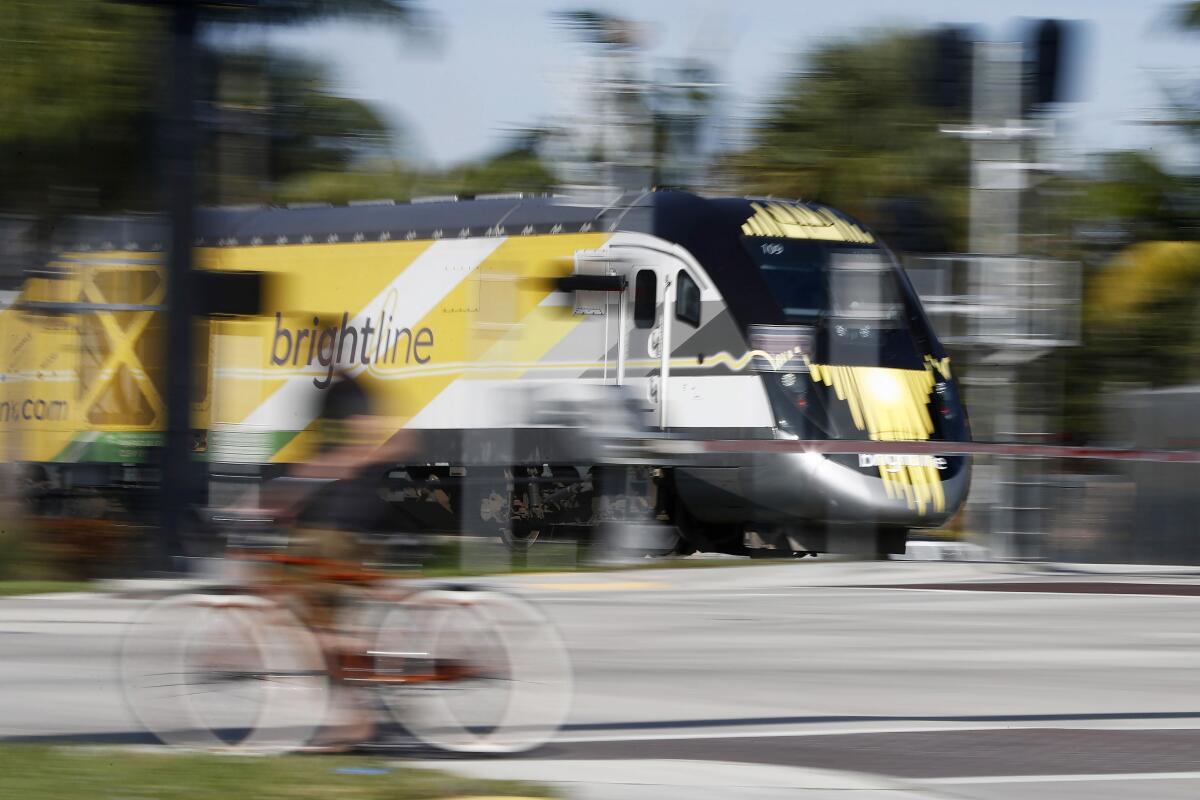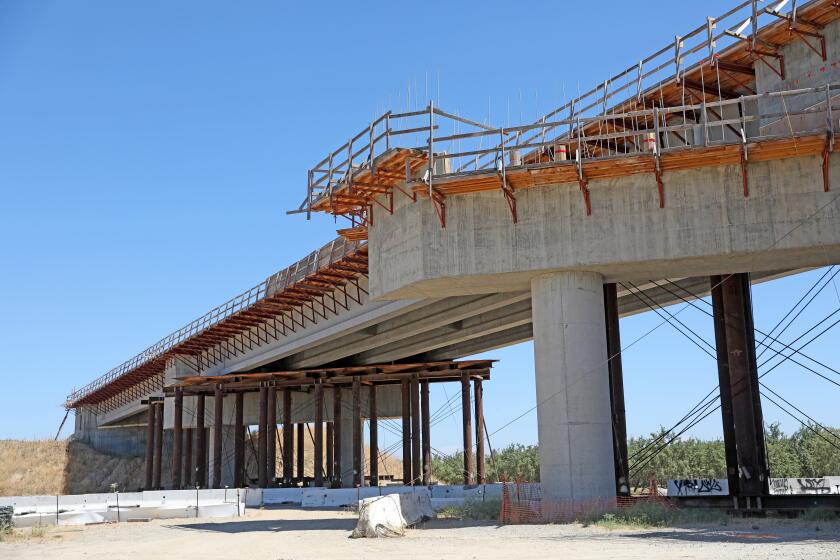SoCal to Vegas in two hours? High-speed rail comes closer to reality with $3-billion award

- Share via
A high-speed rail project between the Inland Empire and Las Vegas landed a $3-billion federal grant that sets it on track to be open by 2028, in time for the Olympic Games in Los Angeles, officials said Tuesday.
Brightline, a private company that completed the final phase of the intercity rail line connecting Miami and Orlando, Fla., this year, secured the U.S. Department of Transportation grant as part of the historic infrastructure package, Nevada’s U.S. senators said. The rest of the funds for the $12-billion project are expected to be raised through private capital and bonds.
The trip on the 218-mile electrified line from Rancho Cucamonga to Las Vegas will take just over two hours, with stops in Hesperia or Apple Valley, according to Brightline. The trains can reach speeds of 200 miles per hour. The company already has the federal permits, the labor agreements and the land — a swath in the wide median of Interstate 15 — to build the line. Construction is expected to begin early next year.
Three wildlife crossings have been added to a planned high-speed rail line project connecting Las Vegas and Southern California.
In Southern California, the line will connect to the Metrolink commuter train system, linking it directly to downtown Los Angeles. In Las Vegas, the terminus will be on the south end of Las Vegas Boulevard.
The company operates the only high-speed private rail service in the United States, and its rapid rise runs in stark contrast to California’s effort to build a high-speed rail between Los Angeles and the Bay Area, which has been mired in politics, cost overruns and delays.
California’s separate $3.1-billion application for that project was also approved. Gov. Gavin Newsom said in a letter to the White House the grant would allow the state to complete an initial 119-mile segment under construction with double tracks in the Central Valley, build a downtown Fresno rail station, acquire six train cars and get construction ready for the remaining 52 miles of the first phase of construction, stretching from Bakersfield to Merced. That 171-mile leg of the project is now estimated to cost up to $35 billion.
Whether Brightline West can come to fruition on budget and in such a short time will be a major test for the future of high-speed rail, said Yonah Freemark, a researcher at the Urban Institute that follows the development of the industry in the U.S.
Cutting through two states and across the steep mountainous areas of the Cajon Pass can pose unforeseen challenges, he said. And one shortcoming is simply the route. It’s not a true downtown-to-downtown connection.
“One of the reasons why California High Speed Rail is so expensive is that it’s trying to get downtown. That requires having to go through extremely congested areas,” Freemark said.
But Brightline is showing promise in Florida. Last year, the company completed the final leg of a $6-billion, 235-mile line that connects Orlando and Miami. If the company is able to turn a profit in Florida and build high-speed rail in Southern California, it could mark a dramatic shift for passenger rail.
“It could imply a substantial expansion in private investment in railways in the United States that we have not seen in 100 years,” Freemark said.
The U.S. intercity rail system was largely built up by private investors, but private train cars haven’t operated for decades. Most passenger rail service in the U.S. is run by Amtrak, a privately operated but publicly funded corporation. And the shift away from rail is seen daily in airports and choked freeways.
“The Biden administration is really leading the charge on trying to make this a reality in America,” said Andy Kunz, president and chief executive of the U.S. High Speed Rail Assn.
The 2021 infrastructure bill had about $41.5 billion in funding for programs related to high-speed rail, according to the association. This week the Biden administration is expected to announce millions more dollars dedicated to rail projects across the country.
Although this project would be the first major foray into high-speed rail in the U.S., China, Japan and numerous European countries have long embraced the mode of transportation, with trains connecting many major cities.
“True high-speed rail is what’s transformative. Regular rail is OK, but it doesn’t pull people by the millions out of airplanes or out of cars,” Kunz said. “It’s not fast enough or frequent enough.”
Kunz said he’s confident Brightline will be able to build the Vegas line quickly.
“They’ve been planning now for several years already with their contractor to be laying like a mile of track a day,” he said.
The Brightline grant application was co-submitted with the Nevada Department of Transportation.
The latest report from the California High-Speed Rail Authority projects costs for the initial segment at $35 billion, which exceeds secured funding by $10 billion.
“This is a historic moment that will serve as a foundation for a new industry, and a remarkable project that will serve as the blueprint for how we can repeat this model throughout the country,” said Wes Edens, founder and chairman of Brightline. “We’re ready to get to work to bring our vision of American-made, American-built, world-class, state-of-the-art high-speed train travel to America.”
Although Brightline did not get the full $3.7-billion package that it hoped for, the grant will ensure the project’s construction, officials said. The train is conceived as both a premium tourist train and a more traditional transportation link between Southern California and Las Vegas, two regions with deep ties. The company has said that passengers may ultimately be able to check into their Las Vegas hotels at the train station.
“This historic high-speed rail project will be a game-changer for Nevada’s tourism economy and transportation,” said Sen. Jacky Rosen (D-Nev.). “It’ll bring more visitors to our state, reduce traffic on the I-15, create thousands of good-paying jobs and decrease carbon emissions, all while relying on local union labor.”
More to Read
Sign up for Essential California
The most important California stories and recommendations in your inbox every morning.
You may occasionally receive promotional content from the Los Angeles Times.













